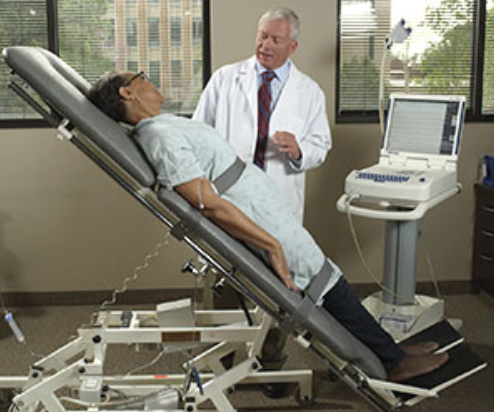Your nervous system can suddenly lower your heart rate and blood pressure when you switch from lying down to an upright position. When you sit or stand up from lying down, less blood travels to your brain and can cause you to faint. Fainting is also called syncope. A tilt table models this action to find the cause of your symptoms.
In order to prepare for the test, you may be asked not to eat or drink anything beforehand. Unless your doctor tells you otherwise, you can usually take all your medications regularly.
You will be asked to lie flat on a table with a footboard. Straps will be placed around you to keep you in place while the table moves. The technician will place a set of EKG electrodes at various locations on your chest, arms, and legs. They will place a blood pressure monitor or cuff on you to check your blood pressure throughout the test. If needed, an IV line will be placed in your arm to deliver medications. The test will begin with you lying flat on your back on the table for 5 minutes. The table will move you to a nearly vertical position, where you will stay for 5-45 minutes. While you are in this position, you will be asked to stay as still as possible but to report any symptoms that you are having. If you do not faint or have symptoms during this time, the doctor may give you isoproterenol through the IV, which might cause you to faint. If you don't faint, you will stay in the nearly vertical position for about 20 more minutes. If you faint while vertical, you will be returned to a horizontal position and monitored. Most people regain consciousness immediately. Your blood pressure and heart rate will be watched in each position to see what your response is to the changing positions. If blood pressure or heart rate changes show that you might faint, the table is moved back horizontally so that you stay conscious. After the test is over, you can resume normal activities, unless otherwise told by your doctor.
Complications with tilt tables are rare and the test is mostly safe. Some potential complications include nausea and vomiting after fainting, weakness, and low blood pressure after the test. You may also feel these symptoms when the table is in the upright position. However, these usually go away when the table is moved back to a horizontal position.
The results of the test are dependent on whether you faint and what changes occur in your heart rate and blood pressure. If your blood pressure decreases and if you feel dizzy/faint during the test, the results are positive. This suggests that your fainting episodes are caused at least partly by your nervous system. If your heart rate increases slightly, your blood pressure does not drop, and you do not have symptoms of fainting, the results are negative. False negative results are somewhat common: some people do not respond to the tilting but do have nervous system problems causing their fainting. Your doctor may order additional tests to rule out other causes of fainting.










